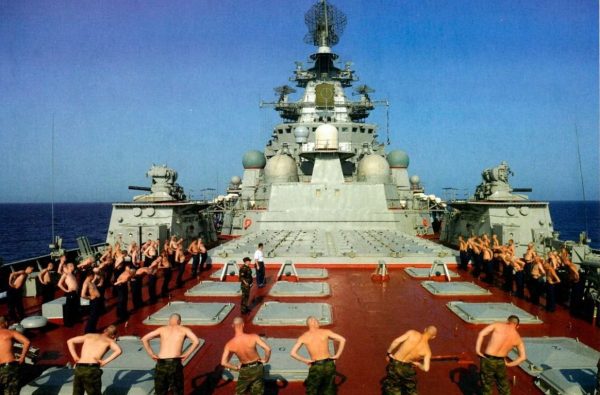A Complete Guide To The Kirov-Class Cruiser

The Peter the Great battle cruiser being intercepted by a Royal Navy destroyer on its way to the Mediterranean.
Historians may never agree on the exact year that represented the height of the Cold War but it was in 1975 when, for the first time ever, the Soviet nuclear arsenal surpassed America’s in sheer warheads.
Then it began to grow, larger and larger.
The same principle applied to the Soviet Navy. The threat of US carrier battle groups was too great to ignore. The proper response was a radical approach to shipbuilding. Not submarines or aircraft carriers, whose technology the Soviets struggled to grasp, but enormous fighting vessels whose purpose was to travel the oceans and kill entire fleets with a hail of missiles.
By 1980 the Soviet nuclear arsenal was ahead of America’s by 5,000 warheads and Afghanistan was in Moscow’s orbit. That same year, when the entire Soviet system was reeling from economic mismanagement, the first Project 1144 Kirov-class missile cruiser was commissioned.
Displacing between 23,000 to 25,000 tons and recognized as the largest warship of the late 20th century the Kirov was the eldest among five siblings to accompany the first Soviet carrier battle groups. Next came the Frunze, commissioned in 1984, and after it was the Kalinin in 1988. The fourth in line wasn’t completed until the mid-1990s and the fifth never materialized.
The holdout among the Kirovs was no longer a Soviet ship by 1996, and as per the custom of the Russian Navy, it was christened Peter the Great or Pyotr Velikiy, hull number 099, and made a flagship of the Northern Fleet. Peter was the last of what the Americans dubbed the Russian battle cruisers.
Peter the Great stayed on when his brothers were removed from service in 1990 and 1999. Armed to the teeth for a war that never came, in just 20 years these exorbitant and ruinous behemoths proved useless to their masters.
The Kirovs were unique for their nuclear propulsion. Each ship was a hybrid, equipped with two nuclear reactors and two steam turbines, giving them an impressive top speed of 35 knots. If adequate provisions were available for its 800-odd crew the Kirovs remained at sea for as long as needed.
Their singular purpose, however, was to defeat the US Navy in the event of an oceanic war. This is why each Kirov maintained a baffling arsenal. This included:
- A set of 20 Granit anti-ship missiles ( NATO code name is “Shipwreck”) housed in a vertical launch system beneath the superstructure.
- An inventory of 96 S-300F and S-300FM long-rang SAMs.
- An inventory of SA-N-20 short-range SAMs.
- Six Kashtan CIWS.
- Four AK-630 30mm gatling guns / CIWS
- A small stockpile of Viyuga torpedoes.
- A twin-barrel AK-130 naval gun.
- A hangar for three Ka-27 anti-submarine warfare helicopters.
This lethal selection that surpassed the collective firepower of a Third World navy was meant to render the Kirov battle cruiser impervious to air and missile attack. The combination of the Voshkod MR-800 and the Fregat MR-710 search radars allowed it to target enemy flotillas from 300 kilometers away and eliminate them with anti-ship missiles.
The Kirov’s anti-submarine capabilities were just as bothersome. A sonar system installed on the hull was powerful enough to scour the ocean depths and its deck bristled with anti-submarine rocket launchers to complement its 10 torpedo tubes.
Everybody knows how the Cold War ended and what befell the Soviet Navy. The four Kirov battle cruisers never lived up to their hype. The Northern Fleet’s Peter the Great arrived late and endured a boring career while the Kalinin (renamed Admiral Nakhimov) and the Frunze (renamed Admiral Lazarev) were abandoned in separate ports. The original Kirov (renamed Admiral Ushakov) was condemned to never-ending refurbishment. This process has dragged on longer than its own brief service with the Soviet and Russian navies from 1980 until 1990.
Peter the Great did enjoy some recent usefulness. In 2016 it traveled to the Syrian coast as part of Putin’s blitz on the country. But the sweeping modernization of Russia’s armed forces is bringing these old hulls to life.
The Admiral Nakhimov is being upgraded in Severodvinsk for its re-commissioning in 2018. He will be followed by an overhauled Peter the Great in 2020. Both battle cruisers have future roles as possible missile defense platforms for Russia’s long Arctic coastline thanks to new S-400 air defense systems.
The Admiral Ushakov should join them by the 2020s and perhaps the Admiral Lazarev will complete the quartet.
Having the Kirovs around makes sense for another likelihood. If the Russian Navy must prosecute a campaign in East Asia or the Middle East, it’s useful to have the missile-armed Admirals on call. Should Moscow make good on its intentions for a next-generation nuclear-powered supercarrier (where the money to pay for it comes from is anyone’s guess) then having a spare Admiral Nakhimov or Ushakov is perfect for escort duties.
Bringing the Kirovs back into the fold is a necessary step for Russia, whose once mighty shipbuilding sector is still languishing from years of neglect. It’s a strategy of exploiting an available platform rather than pay too much for a brand new warship class. Besides, new hypersonic cruise missiles and stealth detecting radars can enhance the Kirov’s deterrent force on NATO, the US Navy, and whoever comes looking for trouble with Moscow.
In the meantime Peter the Great is all by his lonesome.

















Trackbacks
Comments are closed.